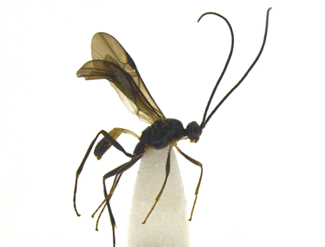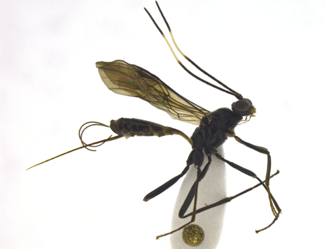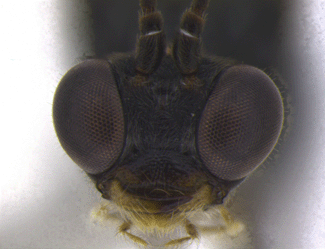LIFE HISTORY
DATA
|
Diagnostic features of adult
wasp
|
Body length 6.4-9.8 mm; 30-36 flagellomeres; body mostly
black, female antenna with median white band, petiole of
first metasomal tergite yellowish white basally in female,
entirely pale in male; mandible not twisted; clypeus
punctate; occipital carina complete; wings slightly
darkened; propodeum carinate-rugose, with distinct median
and transverse carinae defining large areolae; tarsal claw
simple; dorsopes absent; ventral borders of first metasomal
tergite separated basally, joined apically; ovipositor 2.6 x
longer than first metasomal tergite; first tergite smooth
dorsally.
|
Biology and rearing
records
|
Hosts and development are unknown. Adults of Meteorus
gigas are commonly sampled by Malaise traps and yellow
pan traps, and are known to fly during all months of the
year except August and September. It is interesting to note
that while more than 60,000 individual caterpillars have
been reared so far in the Ecuador CAPEA project, M.
gigas has not yet been reared from a host caterpillar.
The abundance of this species in Malaise traps from the same
area illustrates a gap between sampling methods and shows
the importance of using diverse sampling methods for
assessing Braconidae biodiversity. Since the common
caterpillars on low vegetation at Yanayacu have now been
well sampled, the absence of M. gigas from these
hosts suggests that the species may selectively parasitize
either very cryptic hosts, nocturnal feeders, or hosts
feeding high in the forest canopy. Perhaps this species
parasitizes beetle host that are not being sampled by the
CAPEA project.
|
Distribution
|
Meteorus gigas is the most common Meteorus
species found flying at the Yanayacu Biological Research
Station in Napo Province, Ecuador. The species also occurs
in Andean and high Andean wet forests in Colombia. It is
known from elevations ranging from 1950 to 2213 meters.
|
Similar species
|
Meteorus gigas is similar to Meteorus megalops
(Zitani) (from Costa Rica and Colombia). Both species
have the mandibles not twisted, large and protuberant eyes,
small ocelli, antennal flagellum with a white median band in
females, occipital carina complete, similar first metasomal
tergite form, and long ovipositor. Meteorus gigas
differs by being strikingly larger (females 8.0 to 9.8 mm
long vs. 5.4 mm or shorter), and having more flagellomeres
(30-36 flagellomeres in gigas vs. 24-25 in
megalops). Other characteristics separating these
two species are given by Aguirre et al. (2010).
|
Comments
|
The species name gigas means "giant" or "large" in
Latin, referring to the exceptionally large body size for a
Meteorus species.
|
Reference
|
Aguirre Fernandez, H., S.R. Shaw, and G.Z. Jones. 2010.
A new Meteorus species from Colombia and Ecuador
(Hymenoptera: Braconidae). Zootaxa 2453: 55-61.
Aguirre Fernandez, H., C.E. Sarmiento, and S.R. Shaw.
2011. Taxonomic revision and morphometric analysis of
Meteorus Haliday 1835 (Hymenoptera: Braconidae:
Meteorinae) from Colombia. Zootaxa 2938: 1-68.
|



